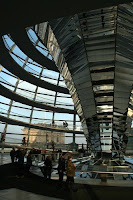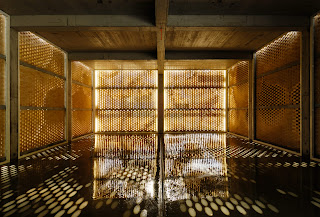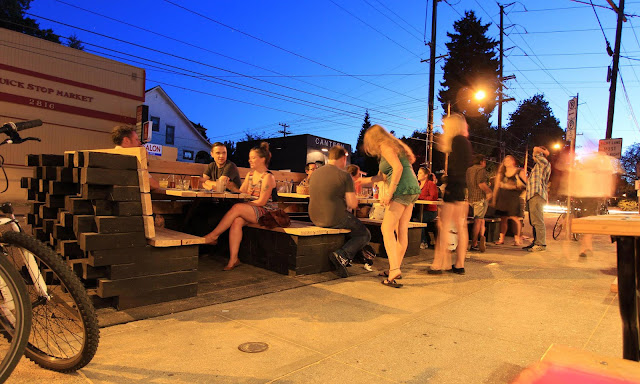The Reichstag
Berlin, Germany - designed by Foster + Partners
By Lucas Gray
 A monument of Germany's past has been given a new life in the redesigned Reichstag. First opened in 1894 the Reichstag was built to house the parliament of the German Empire. It stood as a symbol of democracy for close to forty years until communist arsonists severely damaged the structure in 1933. Throughout World War II and up until the reunification of Germany in the late 1980s it sat as an empty shell - a symbol of a nation that had been torn apart by war and politics. It was here that the official reunification ceremony was held as it sits along the former border between East and West Berlin. When Germany’s government was moved to Berlin from Bonn in the early 1990s the Reichstag was returned to prominence and once again became the home of Parliament and the symbol of German Democracy.
A monument of Germany's past has been given a new life in the redesigned Reichstag. First opened in 1894 the Reichstag was built to house the parliament of the German Empire. It stood as a symbol of democracy for close to forty years until communist arsonists severely damaged the structure in 1933. Throughout World War II and up until the reunification of Germany in the late 1980s it sat as an empty shell - a symbol of a nation that had been torn apart by war and politics. It was here that the official reunification ceremony was held as it sits along the former border between East and West Berlin. When Germany’s government was moved to Berlin from Bonn in the early 1990s the Reichstag was returned to prominence and once again became the home of Parliament and the symbol of German Democracy.
 An extensive renovation project preserved the historic shell of the building while using high tech systems to bring the building up to date and make it more environmentally sustainable. An international design competition was held and ultimately won by internationally renowned British architect Norman Foster. The entire building has been retrofitted with all interior walls and floors removed and then redesigned. Only the exterior facades were preserved. Internal court yards bring natural light deep into the building and provide natural ventilation.
An extensive renovation project preserved the historic shell of the building while using high tech systems to bring the building up to date and make it more environmentally sustainable. An international design competition was held and ultimately won by internationally renowned British architect Norman Foster. The entire building has been retrofitted with all interior walls and floors removed and then redesigned. Only the exterior facades were preserved. Internal court yards bring natural light deep into the building and provide natural ventilation.
The dominant aesthetic feature is the large glass cupola that rises above the heavy stone walls. It was not part of the original competition scheme but was added to reference the dome that used to sit atop the building. It features a complex system of louvers, screens and reflectors that bring natural light streaming down into the parliament chambers. The dome is open to the public, becoming a symbol to the openness and transparency of the new German Democracy. The entire rooftop has been transformed into an observation platform overlooking the city of Berlin.
 A spiraling ramp twists around the glass dome providing spectacular views of the city and an ever-changing perspective of the stunning mirrored reflector. Fragmented views of the surroundings, fellow visitors, and the sun create a mosaic effect on this object dominating the space. A large carefully calculated sunscreen tracks the sun and prevents overheating and intense direct sunlight from disturbing the inhabitants below.
A spiraling ramp twists around the glass dome providing spectacular views of the city and an ever-changing perspective of the stunning mirrored reflector. Fragmented views of the surroundings, fellow visitors, and the sun create a mosaic effect on this object dominating the space. A large carefully calculated sunscreen tracks the sun and prevents overheating and intense direct sunlight from disturbing the inhabitants below.
Thousands of visitors wait for hours to get a chance to visit this gem of contemporary design. It has become one of Berlin’s most visited attractions and continues to draw large crowds, even ten years after completion. Although it has seen its share of criticism it has ultimately been a great success and has grown into a wonderful symbol of the German government and the city of Berlin. It is a great example of how architecture can become something greater than a mere utilitarian building and provide meaning and pride to an entire nation.
By Lucas Gray
 A monument of Germany's past has been given a new life in the redesigned Reichstag. First opened in 1894 the Reichstag was built to house the parliament of the German Empire. It stood as a symbol of democracy for close to forty years until communist arsonists severely damaged the structure in 1933. Throughout World War II and up until the reunification of Germany in the late 1980s it sat as an empty shell - a symbol of a nation that had been torn apart by war and politics. It was here that the official reunification ceremony was held as it sits along the former border between East and West Berlin. When Germany’s government was moved to Berlin from Bonn in the early 1990s the Reichstag was returned to prominence and once again became the home of Parliament and the symbol of German Democracy.
A monument of Germany's past has been given a new life in the redesigned Reichstag. First opened in 1894 the Reichstag was built to house the parliament of the German Empire. It stood as a symbol of democracy for close to forty years until communist arsonists severely damaged the structure in 1933. Throughout World War II and up until the reunification of Germany in the late 1980s it sat as an empty shell - a symbol of a nation that had been torn apart by war and politics. It was here that the official reunification ceremony was held as it sits along the former border between East and West Berlin. When Germany’s government was moved to Berlin from Bonn in the early 1990s the Reichstag was returned to prominence and once again became the home of Parliament and the symbol of German Democracy. An extensive renovation project preserved the historic shell of the building while using high tech systems to bring the building up to date and make it more environmentally sustainable. An international design competition was held and ultimately won by internationally renowned British architect Norman Foster. The entire building has been retrofitted with all interior walls and floors removed and then redesigned. Only the exterior facades were preserved. Internal court yards bring natural light deep into the building and provide natural ventilation.
An extensive renovation project preserved the historic shell of the building while using high tech systems to bring the building up to date and make it more environmentally sustainable. An international design competition was held and ultimately won by internationally renowned British architect Norman Foster. The entire building has been retrofitted with all interior walls and floors removed and then redesigned. Only the exterior facades were preserved. Internal court yards bring natural light deep into the building and provide natural ventilation.The dominant aesthetic feature is the large glass cupola that rises above the heavy stone walls. It was not part of the original competition scheme but was added to reference the dome that used to sit atop the building. It features a complex system of louvers, screens and reflectors that bring natural light streaming down into the parliament chambers. The dome is open to the public, becoming a symbol to the openness and transparency of the new German Democracy. The entire rooftop has been transformed into an observation platform overlooking the city of Berlin.
 A spiraling ramp twists around the glass dome providing spectacular views of the city and an ever-changing perspective of the stunning mirrored reflector. Fragmented views of the surroundings, fellow visitors, and the sun create a mosaic effect on this object dominating the space. A large carefully calculated sunscreen tracks the sun and prevents overheating and intense direct sunlight from disturbing the inhabitants below.
A spiraling ramp twists around the glass dome providing spectacular views of the city and an ever-changing perspective of the stunning mirrored reflector. Fragmented views of the surroundings, fellow visitors, and the sun create a mosaic effect on this object dominating the space. A large carefully calculated sunscreen tracks the sun and prevents overheating and intense direct sunlight from disturbing the inhabitants below.Thousands of visitors wait for hours to get a chance to visit this gem of contemporary design. It has become one of Berlin’s most visited attractions and continues to draw large crowds, even ten years after completion. Although it has seen its share of criticism it has ultimately been a great success and has grown into a wonderful symbol of the German government and the city of Berlin. It is a great example of how architecture can become something greater than a mere utilitarian building and provide meaning and pride to an entire nation.






